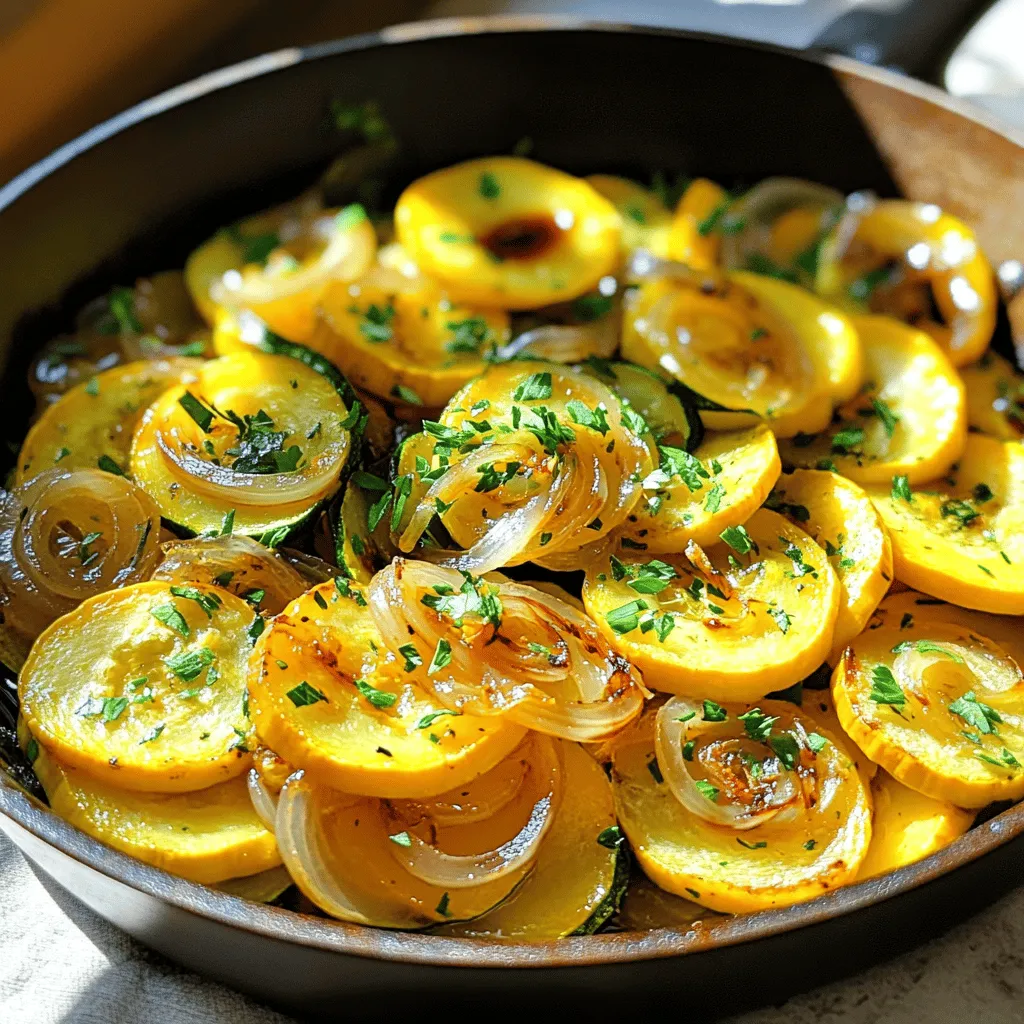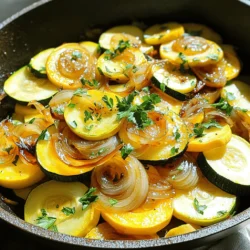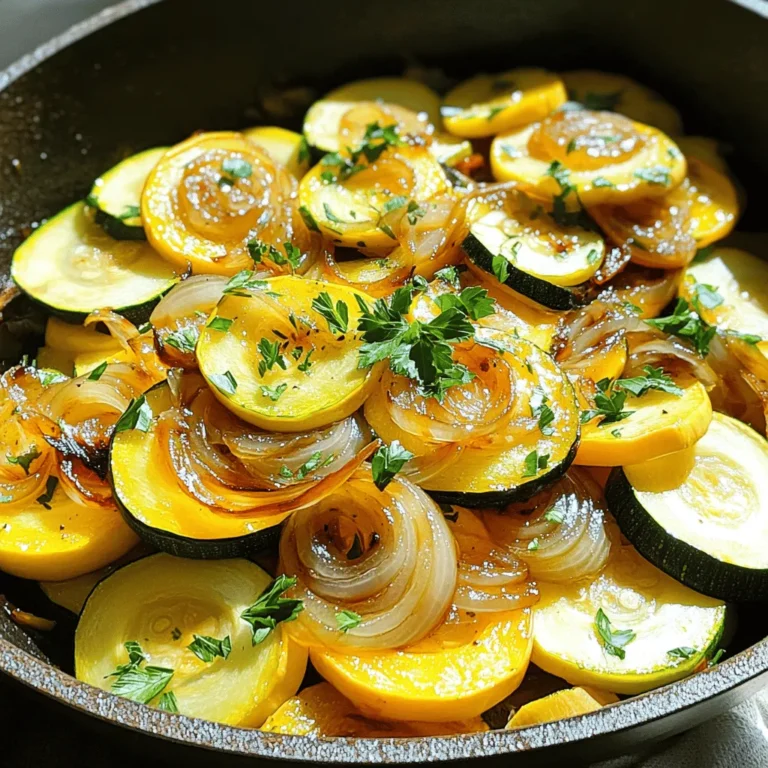Are you ready to bring back a classic dish that warms the heart? In this easy cooking guide, I’ll show you how to make Old-Fashioned Squash and Onions. This simple recipe pairs flavors well and is perfect for any meal. Whether you are cooking for yourself or a crowd, this guide has everything you need. Let’s dive into the ingredients and get started on this delicious journey!
Ingredients
List of Required Ingredients
To make Old-Fashioned Squash and Onions, gather these items:
– 2 medium yellow squash, sliced
– 2 medium zucchini, sliced
– 1 large onion, thinly sliced
– 2 tablespoons olive oil
– 1 teaspoon garlic powder
– 1 teaspoon dried thyme
– Salt and pepper to taste
– ½ cup vegetable broth
– 1 tablespoon balsamic vinegar
– Fresh parsley, chopped
Ingredient Tips for Best Flavor
Choose fresh squash and zucchini for the best taste. Look for bright colors and firm skin. Use a sweet onion, like Vidalia, for a nice contrast with the squash. Olive oil adds richness. For a deeper flavor, try using high-quality balsamic vinegar. This will really elevate the dish. Always taste as you go to adjust seasoning.
Substitutions for Dietary Preferences
If you need to change any ingredients, here are some ideas:
– Replace olive oil with avocado oil for a different flavor.
– For a low-sodium option, use low-sodium vegetable broth.
– If you prefer fresh herbs, swap dried thyme for fresh thyme.
– You can skip the balsamic vinegar if you want a lighter dish.
Step-by-Step Instructions
Detailed Cooking Instructions
To make this dish, start by heating olive oil in a large skillet over medium heat. Add the thinly sliced onions. Sauté them for about five minutes until they are soft. Next, add the sliced yellow squash and zucchini. Stir well to mix. Cook these for another six to eight minutes. The veggies should start to soften.
Now, sprinkle in the garlic powder, dried thyme, salt, and pepper. Mix everything well to coat the vegetables with these spices. This step adds flavor. Pour in the vegetable broth and balsamic vinegar. Reduce the heat to low and cover the skillet. Let it simmer for about ten to twelve minutes. The squash should be tender and soak up the flavors. Taste your dish and adjust the seasoning if needed.
Finally, remove the skillet from the heat. Transfer the squash and onions to a serving dish. Garnish with fresh chopped parsley. This adds a nice touch and some color.
Recommended Cooking Techniques
When cooking squash and onions, remember to keep the heat moderate. This helps the vegetables cook evenly. Stir often to prevent sticking. If you like a bit of crispiness, you can cook them uncovered for a few extra minutes.
Using a lid traps steam, which helps soften the squash. If you want a deeper flavor, let it cook a little longer. Just keep an eye on it so it doesn’t burn. You can also try roasting the veggies in the oven. Toss them with oil and spices, then roast at 400°F for about twenty minutes.
Presentation Tips for Serving
Presentation can make your dish stand out. Use a colorful plate for serving. Place the squash and onions in the center, making a nice mound. Sprinkle the fresh parsley on top for a pop of green.
You can also add a drizzle of balsamic vinegar around the plate for flair. This gives a nice visual and enhances the taste. Serve this dish warm as a side or a main. It pairs well with grilled meats or crusty bread. Enjoy your cozy squash and onion medley!
Tips & Tricks
How to Perfectly Cook Squash and Onions
To cook squash and onions just right, start with fresh veggies. I love using medium yellow squash and zucchini. Slice them evenly for uniform cooking. Heat olive oil in a skillet over medium heat. Add the onions first to soften. This takes about five minutes. Then, mix in the squash and zucchini. Stir them well and cook for six to eight minutes. This helps all the flavors blend. Use garlic powder and thyme to season. They add great taste without much effort. Pour in vegetable broth for moisture, then let it simmer. Cover the skillet to trap the heat. This method keeps the squash tender and flavorful.
Common Mistakes to Avoid
One mistake many people make is overcrowding the pan. This traps steam, making the veggies soggy. Give them space to cook. Another mistake is not seasoning early. Adding herbs at the start helps the flavors soak in. Also, don’t skip the vegetable broth. It adds depth and keeps the squash from drying out. Lastly, don’t rush the simmering process. Allowing the dish to cook longer helps the veggies absorb all those great flavors.
Flavor Enhancements and Seasoning Suggestions
To take this dish up a notch, consider adding some zest. A squeeze of lemon juice brightens the flavors. You can also use fresh herbs, like basil or oregano, for a twist. If you like a bit of heat, add red pepper flakes. For a sweeter taste, try a dash of maple syrup or honey. Don’t forget to taste and adjust your seasonings! Fresh parsley makes for a lovely garnish and adds a pop of color.

Variations
Alternative Versions of Squash and Onions
You can switch up this dish in many ways. Try using different types of squash, like butternut or acorn squash. You can also mix in sweet potatoes for a unique twist. Some love to add bell peppers for color and taste. Experiment with spices too! Try cumin or paprika for a smoky flavor.
Adding Proteins or Other Vegetables
Want to make this dish heartier? Add proteins like chicken, sausage, or even beans. Simply cook the protein first, then add the squash and onions. You can also toss in other veggies like spinach or carrots. They add great texture and nutrients. Just remember to adjust cooking times as needed.
Serving Suggestions as a Side Dish or Main Course
This dish fits well as a side or a main meal. Serve it next to grilled meats or fish for a nice balance. If you want it as a main course, pair it with rice or quinoa. You can also top it with cheese or nuts for extra flavor.
Storage Info
How to Properly Store Leftovers
After you cook your old-fashioned squash and onions, let them cool down. Place the leftovers in an airtight container. This keeps them fresh and tasty. Store them in the fridge. They will last for about three to five days. If you want to keep them longer, consider freezing.
Reheating Instructions
To reheat, you can use the microwave or the stove. For the microwave, place the squash and onions in a bowl. Cover it with a lid or a paper towel. Heat for one to two minutes. Stir halfway through to ensure even heating. If you use the stove, heat a pan over low heat. Add a splash of vegetable broth to help steam and warm them up. Cook until warm, stirring often.
Freezing Tips for Long-term Storage
Freezing is a great way to save your squash and onions. First, cool them completely. Next, use a freezer-safe container or bag. Remove as much air as you can from the bag. Label it with the date. When stored this way, they can last for up to three months. When you are ready to enjoy, thaw them in the fridge overnight. You can then reheat them as needed.
FAQs
What is the best type of squash to use for this recipe?
I recommend using yellow squash and zucchini for this dish. They both cook well and provide great flavor. Yellow squash has a mild taste, while zucchini adds a nice texture. Together, they create a lovely medley. You can also use acorn squash or butternut squash if you want a sweeter flavor.
Can I make this dish vegan?
Yes, you can easily make this dish vegan. The recipe is already plant-based since it uses vegetable broth and no animal products. Just ensure your balsamic vinegar is vegan-friendly. This dish is both tasty and healthy, making it perfect for everyone.
How do I adjust the recipe for larger servings?
To adjust the recipe, simply double or triple the ingredients. For example, use 4 medium yellow squash and 4 medium zucchini for a larger batch. You can also increase the onion and spices to match. Just make sure your skillet is big enough to hold everything.
What are some common cultural variations of squash and onions?
Many cultures have their own twists on squash and onions. In Italy, they may add tomatoes and herbs like basil. In India, spices like turmeric and cumin can create a whole new dish. In other regions, you might find recipes with cheese or different types of broth. These variations show how versatile squash and onions can be.
You now know how to make delicious squash and onions. We covered ingredients, cooking steps, and tips for perfect flavor. I shared how to store leftovers and answered common questions. Use the tips for great results every time. Try new variations to keep things fresh. Cooking should be fun, so experiment and enjoy your meals!


